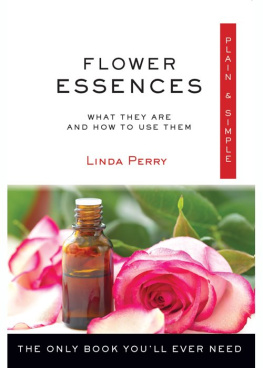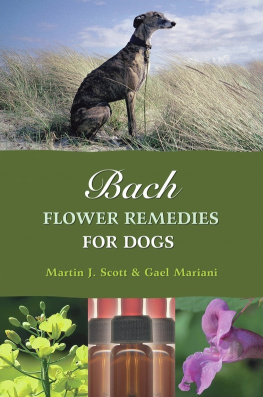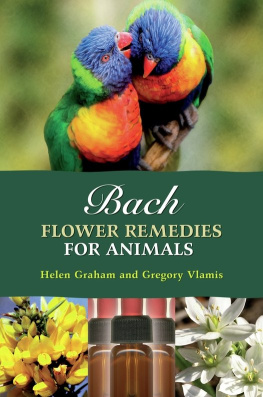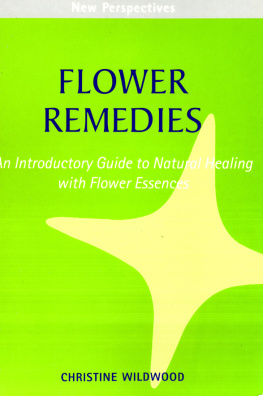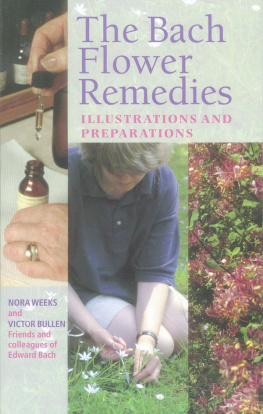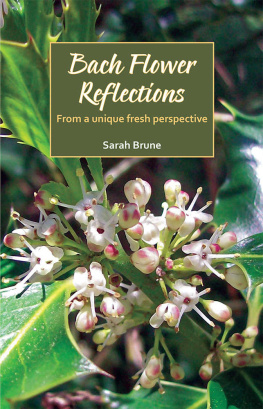C HAPTER O NE
I NTRODUCTION TO D R . B ACHS H EALING R EMEDIES
I can think of no better means of introducing the Bach Flower Remedies than to quote Dr. Bachs steadfast companion and devoted helper, Nora Weeks. Nora dedicated her life to the doctors work, upholding all its principles and the most vital and fundamental essence of all, its simplicity. The following is an excerpt from a talk she gave many years ago. Dr. Bachs work is depicted beautifully by the person who knew it best.
Will you, for the next half hour or so, turn your thoughts from the healing of the sick body to the healing of the sick person, for Dr. Edward Bach, after many years of research, gained the knowledge that our physical health depends upon our way of thinking, our feelings and emotions.
Good health is harmony, rhythm, when we think positively, constructively, happily. Ill-health when we think negatively, unhappily, destructively.
Such is the power of thought, the power man has over his body which is, after all, only the vehicle, the car he uses on his journey through life on earth.
As some of you may not know anything about the Bach Remedies, I would like first of all to tell you about Dr. Bach himself and how he developed this method of treatment and found the Flower Remedies.
The family came originally from Wales, so the name should be Bach, but his medical colleagues always called him Batch, and we have done so ever since.
Edward Bach trained and qualified at University College Hospital and gained the Diploma of Public Health (D.P.H.) at Cambridge in the early 1900s. He was rather an unusual medical student, for he soon became more interested in the patients themselves than their diseases. He would sit by their bedsides and let them talk to him, and listening to them he found out the real cause of their ill-health. For instance, the woman with severe asthma was a very frightened woman. She told him her only son had taken a job in the north of England over three months ago and she had had no word from him in all that time. She was terrified that he had met with an accident, was badly injured, even that he had died. But one day he came to see her and told her he had found a job nearer home. Within a few days she lost her asthma completely. She no longer needed to hold her breath for her son.
The man with a suspected duodenal ulcer was a very worried man. He had lost his job, his wife was unable to work and he had two young children. Later, when he heard he had been reinstated in his work, he regained his health. He gained a job and lost his ulcer. The medical profession these days says that worry is often the cause of gastric and duodenal ulcers, but it was quite a new idea in those early days.
Dr. Bach began to feel then that treating the physical symptoms was not enough. The body was a mirror reflecting the thoughts in the mind. It was the sufferer himself, the person, who needed treatment and help to overcome his worries, fears, depressions, hopelessness. He felt that a completely new method of treatment was needed, a practical one, for words were not enough; it was of little use to say to a worried man, Dont worry, be happy.
But first of all the doctor wanted to prove and test for himself other methods of orthodox medicines and he became a bacteriologist. He was well-known for his research work in this branch of medicine, but it did not satisfy him. He was still treating bodies and not people, and he much disliked the injection of the products of disease back into the human body. However, these years were not wasted, for he was studying his patients, his friends, everyone he came across, and watching their reactions to all the experiences of daily life; at work and at play, in good health and ill-health; and this knowledge of human nature was to stand him in good stead later on.
Then it was he came into contact with homoeopathy, and was delighted to find that Hahnemann, the founder of homoeopathy, had said, The patient is the most important factor in his healing. Also, that homoeopathic remedies were prescribed for the personality of the patient, his characteristics, his idiosyncrasies as well as the physical symptoms.
Dr. Bach worked for some time in the laboratories of the Royal London Homoeopathic Hospital, and it was there that he became interested in the relationship between intestinal toxaemia and chronic disease. I want to tell you about this briefly, because the result of this research brought him a big step forward to his final work.
He isolated seven groups of intestinal flora and prepared nosodes from them homoeopathically, giving them to his patients by mouth. Their purpose is to cleanse and purify the intestinal tract. I say is, for these nosodes, the seven Bach nosodes, the seven bowel nosodes, are still being used today. They were most successful.
Then he made a most important and significant discovery. It was this: all the patients suffering from the same emotional difficulties needed the same nosode, irrespective of the type of physical disease. Those patients who were subject to violent emotional outbursts, brain storms, all needed the same nosode. Those who were nervous, apprehensive, again all needed another but the same nosode, no matter from what physical complaint they suffered.
From then onwards he prescribed these nosodes according to his patients temperamental difficulties only. There was no need for a physical examination of the patient, laboratory tests were unnecessary and treatment could begin at once without delay. The results were excellent.
This confirmed his opinion that physical disease was not of physical origin, but that it was, as he said, the consolidation of a mental attitude.
Dr. Bach now felt he could devote his time and his life to the search for the pure remedies which would help the sufferer rise above his unhappy thoughts. These new remedies he knew must be there for the finding in nature, amongst the trees and plants, for all our needs are provided for in nature by our Creator.
He already knew the principle of the new method of treatment: Treat the patient and not his disease, for when the negative thoughts had been overcome, the body would also respond.
So in 1930 he gave up all his work in London without a backward thought and went to live in the country.
Throughout all those years of medical practice he had been seeking for scientific proof of all his findings and using his intellect, but now a change occurred in himself. He became very sensitive both in mind and body.
Before finding a particular flower, he would suffer in himself and very acutely, the negative state of mind for which that flower was needed and, at the same time, he was privileged, as he said, to suffer from some physical complaint. Then he would wander about the fields and lanes until he found, or was led to find, the flower which would immediately restore his serenity and peace of mind, and within a few hours the physical complaint would also be healed.
In this way he found 38 flowers to cover the 38 negative states of mind from which mankind can suffer. These flowers, with three exceptions, are all the simple wild flowers of the countryside. He prepared the flowers only, for they grow above ground in the sunlight and the air and contain in their hearts the embryo seed, the continued life of the plant. You will know, of course, many of them gorse, heather, honeysuckle, wild rose, chicory, agrimony and the flowers of our well-known trees oak, beech, willow, larch.
Dr. Bach placed the 38 remedies in seven groups. Those for fear; for uncertainty and indecision; for loneliness; for insufficient interest in present circumstances; for over-sensitiveness to ideas and influences; for despondency and despair; for over-care for the welfare of others.





